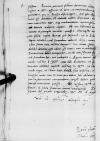Letter #452
[Piotr GAMRAT] to Ioannes DANTISCUSPułtusk, 1538-09-28
| received [1538]-10-09 Manuscript sources:
| ||||
Text & apparatus & commentary Plain text Text & commentary Text & apparatus
Reverendissimo [in Christo Patri et Domino
Reverendissime mi Domine, domine amice et frater carissime et observandissime. Salutem et sui plurimam commendationem.
Redditae sunt mihi cf.
Non debent quidem, Reverendissime mi Domine, in dominiis vicinis et amicis, maxime vero uni domino subiectis, repressalia fieri, sed utique iustitia unicuique administrari debet. Mihi certe videtur, quod dictum vel scriptum sit cum gratia Vestrae Dominationis Reverendissimae, non satis ad rem facere responsum Vestrae Dominationis Reverendissimae, neque secundum ius, neque etiam secundum aequitatem.
Iubet Vestra Dominatio Reverendissima, ut nobilis et iniuriam, et ignominiam detentionis innocenter passus, tam pro supradictis, quam rebus sibi ablatis iustitiam, cum eam apud dominum
Praeterea extenuat factum detentionis nobi[lis] Vestra Dominatio Reverendissima, asserens id iura et consuetudines ill[as] permittere, quae in
Sic etiam istius nobilis detentio, qui alieni est iuris, non secundum i[us] Prutenicum debet compensari et illi satisfactio fier[i], sed secundum hoc, cui subiacet. Agam tamen eg[o] amore Vestrae Dominationis Reverendissimae cum
Me Vestrae Reverendissimae Dominationis favori et solito fraterno amori commendo.
Vestrae Dominationis Reverendissimae obsequens frater
[1 ] cf. IDL 1882


